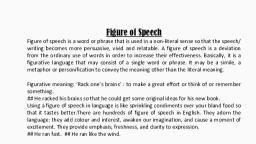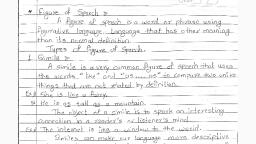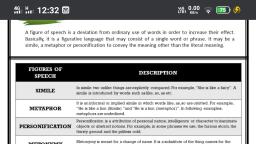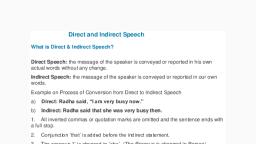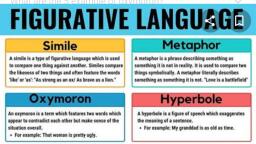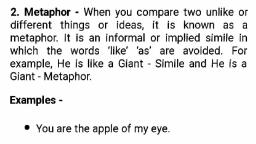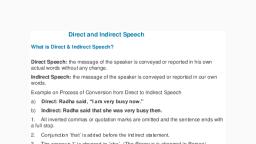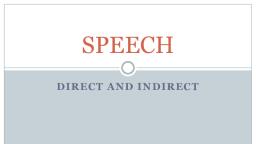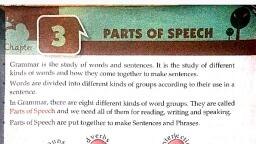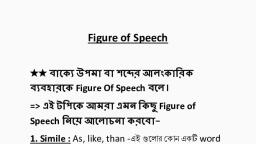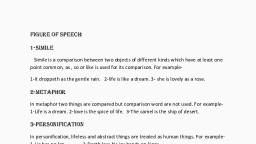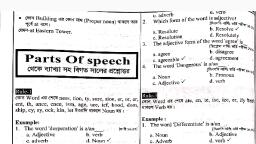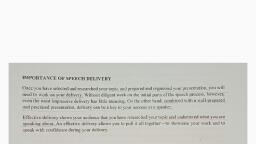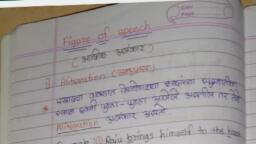Page 1 :
FIGURE OF SPEECH, A word or phrase is said to be used figuratively when it is intended to convey a secondary or derived, meaning (not literal meaning) which is understood by the reader., The figure of speech classified in the following ways:, 1., 2., 3., 4., , Similarity, Contrast, Association and, Arrangement, SIMILARITY, , 1., , 2., , 3., , SIMILE: In the figure of speech comparison is made between two different things, having, one point in common between them. Words like as, like or so, etc. Are used for comparison., Example: He fought like a lion in the battle., The army came like a storm., METAPHOR: Here comparison is made without the use of words like as, so, like, etc. It is, implied or indirect., Example: He is the Hitler of our school., Saurabh is Amitabh Bachhan of our Class., PERSONIFICATION: When non-living objects are given human action, feeling or emotions., It is called Personification., Example: The trees were dancing., The wind shouted, CONTRAST, , 4., , 5., , 6., , 7., , 8., , ANTITHESIS: In the figure of speech, opposite words or contrasting statements are used for, greater effect., Example: Life is full of hope and despair., Man proposes, God disposes., INTERNAL RHYME: When words in the same line rhyme with each other, the figure of, speech is Internal Rhyme., Example: The cattle fought a battle., I had a cat who wore a hat., OXYMORON: When two opposite or contradictory qualities describe the same thing at one, and at the same time, it is Oxymoron., Example: The loving mother punished her child for lying., He is an innocent criminal., IRONY: Here, the real meaning of sentence is exactly opposite of what is being given to us., Example: you are too early for the class., The police station gets robbed., HYPERBOLE: In the figure of speech, the poet exaggerates or makes the overstatement to, emphasize a point., Example: She filled the ocean with her tears., The tea is icy cold.
Page 2 :
9., , 10., , 11., , 12., , 13., , LITOTES: In the figure of speech, a positive idea is conveyed by making the opposite, negative., Example: Mr. Shah is no fool., He is not an ordinary man., EUPHEMISM: Here, the poet refers to harsh facts in a mild way. It is mainly used in the, context of death., Example: He passed away too early. (Died), PUN: In the figure of speech, a word is used in more than one sense., Example: Now you are the man of weight. (Weight in Kilogram, Weight means power), Horse is a stable animal., PARADOX: Paradox is a figure of speech where the statement appears absurd but contains, the truth., Example: War is peace and Freedom is slavery., The child is the father of man., EPIGRAM: It is brief pointed saying which is paradoxical yet true., Example: “If we don’t end war, war will end us.”, “Live simply, so that others may simply live.”, ASSOCIATION, , 14. METONYMY: It means change of name. Here a name or word is used instead of another., Example: The crown has sentenced him death., His face was tired., 15. SYNECDOCHE: When a part is used instead of the whole, it is synecdoche., Example: It is difficult to manage our daily bread., His face was tired., ARRANGEMENT:, 16. REPETITION: When particular words are repeated in the same sentence for greater poetic, effect, it is called Repetition., Example: Rain! Rain! Go away! Go away!, I hope to see my father face to face., 17. ALLITERATION: Here, consonant sounds are repeated in a sentence, for musical effect., Example: She sells sea shells on the sea shore., Shape without forms, shade without colour., 18. TAUTOLOGY: In the figure of speech, there is unnecessary repetition of words that are, similar in meaning. They are used in the same line to produce greater poetic effect., Example: It was a dull and gloomy night., It was a bright sunny day., 19. CLIMAX: Here words are arranged in increasing order of importance., Example: Let a man his obligations to himself, his family, his country, and his God., 20. ANTICLIMAX: This is the opposite of climax. Here, the ideas or words are arranged in a, descending order., Example: He lost his family, his car and his cell phone., 21. ANASTROPHE: Here, the normal order of words is reversed to suit the purpose of the poet., Example: Bites he doesn’t the dog., We the birds betray.
Page 3 :
22. ONOMATOPOEIA: Here, the sound of words suggest or echo the meaning of the word., Example: The buzzing bee flew away., He looked at the roaring., 23. TRANSFERRED EPITHET: In this figure of speech, an adjective or attribute is shifted from, its actual place to another place in the same sentence., Example: The summer clouds are tired., He had a sleepless night., 24. EXCLAMATION: Here, an exclamatory form of sentence is used to draw greater attention to, a plain statement. Strong feelings are conveyed by the exclamation mark. (!), Example: Wow! What a beauty!, The honking horns and zooming motorbikes!, 25. APOSTROPHE: Here, inanimate objects or non-living things are directly addressed by the, poet. Lifeless objects are spoken to, as if they were living., Example: Oh death! Have no pity!, Twinkle, twinkle, little star, How I wonder what you are., 26. INTERROGATION: Question is asked not for getting the answer but to create poetic effect., Example: When will be raining in June?, What are you doing?













